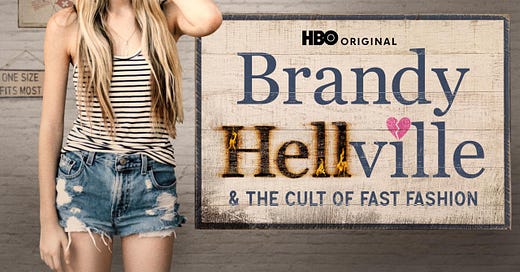Hot Take #2: Brandy 'Hellville' makes the best tank tops
can I love the art but hate the artist?
How did I find myself waiting in line outside of Brandy Melville on Saturday afternoon among a horde of teenage girls? Or “Brandy Hellville,” as a recent HBO documentary calls it, in which the film alleges racism, fatphobia and questionable environmental practices?
I needed white tank tops, and Brandy Melville has the best.
They’re $16, 100% cotton and come in a variety of styles: ribbed, pointelle, racer back and scoop neck. For a shirt that, by the end of the summer, might acquire pit and makeup stains, at $16, the price is right. I own a $95 Re/Done tank and have coveted the $78 Leset pointelle tank, but without my Bloomingdale’s discount, I’m not willing to spend full-price on a shirt that has an expiration date.
Shopping at Brandy is an experience. At 31 years old, I was certainly the oldest customer in the store by a decade, if not double the age of their average clientele. At a size medium, I was certainly one of the largest customers in the store. They notoriously sell “one size fits all” clothes –including jeans – for a customer who hovers closer to a small or extra small. They’ve managed to get away with it and still sell over $200 million of sweaters that look vaguely vintage, baby tees, camisoles, and sweatpants by favoring oversized silhouettes that can permit people like me to dabble.
I took a lap around the store, picking up three tank tops and a t-shirt, and checked out within five minutes. Because everything is one-size-fits-all, I didn’t have to ask if they had my size in the back, and at $16, I didn’t feel obliged to wait in line for a dressing room when I could just try it on at home and, if needed, exchange it within two weeks for store credit – or another tank top.
But for some, Brandy Melville hasn’t gotten away with it. Recent reporting, including the HBO documentary and a Wall Street Journal feature story, reveal teenagers who resorted to disordered eating to fit into the clothes, former employees who had to take daily full body photographs to send to the CEO to ensure they fit his standard of beauty, and workers of color who were relegated to the stockroom versus the sales floor.
If this sounds bad, it’s because it is. If my shopping there sounds like an endorsement of this behavior, it’s not. As someone who grew up in the heyday of Abercrombie and Fitch and Victoria’s Secret, who have reckoned with similar allegations and are also the subject of recent investigative documentaries charting their rise and fall (White Hot: The Rise & Fall of Abercrombie & Fitch and Victoria’s Secret: Angels and Demons), perhaps I’m more primed to the moral rot of corporations and don’t see their values as a reflection of my own.
Critics have been asking themselves a similar question about artists for a long time. Can I love the art but hate the artist? In the book Monsters: A Fan’s Dilemma, author Claire Deder tries to answer this question. Her story begins by trying to reckon with her love for the film Chinatown, often called one of the greatest films of all time, directed by Roman Polanski, and the fact that Polanski drugged and sodomized a thirteen-year-old. To Deder, the film is still great, but it creates a frisson. She can no longer watch it without this knowledge, and this knowledge informs her criticism of the female characters and dynamics of power at play in the film.
To answer the question more broadly, Deder proposes an “online calculator” where “the user would enter the name of an artist, whereupon the calculator would assess the heinousness of the crime versus the greatness of the art and spit out a verdict: you could or could not consume the work of this artist” before rejecting the idea as “laughable, unthinkable” because, as Emily Dickinson wrote, “the heart wants what it wants.” Ultimately, Deder concludes that yes, we can love the art but hate the artist. New Yorker book critic Melissa Febos writes, “The better question is, What then?”
I’d like to imagine that if I had an unlimited budget, I would only buy locally with a transparent supply chain of manufacturers whose values align with my own. In some respects, I’m halfway there. I buy my produce from the farmer’s market, my meat from the local butcher and my wine from a family-run store in my neighborhood. I buy the bulk of my clothing secondhand (thanks to TheRealReal and Poshmark), invest in high-quality shoes and handbags that I repair at my local cobbler, and have proudly never shopped at Shein or Princess Polly.
I cannot fathom how celebrities still wear Dolce & Gabbana on the red carpet despite the founders’ history of repeated racist and homophobic remarks and campaigns when the entire fashion ecosystem is at their disposal. Yes, Kim Kardashian, I’m talking to you. I’d imagine I’d be more like a Michelle Obama, choosing to highlight American designers and Black designers, raising their profile in the process.
Perhaps I’m deluding myself, and I should pay $25 for a tank top at Abercrombie, whose recent about-face to embrace extended sizing and diverse models has resulted in record sales.
I’m curious - Do you put your money where your mouth is?




